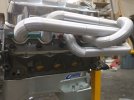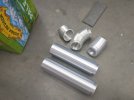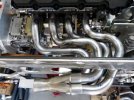PaulProe
Supporter
I have a question for the brain trust - those who have or are using the Icengineworks modeling kit (or clone version) to generate their bundle of snakes exhaust.
The Icengineworks kit is designed so that each adapter has a 1" centerline length with the idea you can match your exhaust tube length very easily. Good in theory but I can see an issue in routing the tubes. Example: using a 4" radius adapter, a 1" centerline length calculates to 14.32 degrees. You can not generate a 90degree bend with the adapters, it is 86 or 100 degrees.
The fit under the body and clearing the necessary pieces can get very complicated and I can see issues if you can't run the pipes on basic angles. ie, the pipe for number 5 runs parallel to the cl of the engine, so to feed it from the #5 exhaust port, you need a 90 degree bend. Using 86 or 100 creates either joint gap issues or a pipe route that is not where you want it to go.
I am probably overthinking this, but curious what others have done. I am working on a clone system and can model the adapters in either 1" CL length or 22-1/2 degree faces. Looking for someone who has used the kit to comment on how they got around the lack of being able to do square corners or how precise their tube joints were before welding. I know for tig welding thin wall, you want as good a joint as possible - an 1/8" gap is just going to be a problem. Likewise, not being able to run the tubes parallel to one another creates another issue.
Thoughts?
Thanks
Paul
The Icengineworks kit is designed so that each adapter has a 1" centerline length with the idea you can match your exhaust tube length very easily. Good in theory but I can see an issue in routing the tubes. Example: using a 4" radius adapter, a 1" centerline length calculates to 14.32 degrees. You can not generate a 90degree bend with the adapters, it is 86 or 100 degrees.
The fit under the body and clearing the necessary pieces can get very complicated and I can see issues if you can't run the pipes on basic angles. ie, the pipe for number 5 runs parallel to the cl of the engine, so to feed it from the #5 exhaust port, you need a 90 degree bend. Using 86 or 100 creates either joint gap issues or a pipe route that is not where you want it to go.
I am probably overthinking this, but curious what others have done. I am working on a clone system and can model the adapters in either 1" CL length or 22-1/2 degree faces. Looking for someone who has used the kit to comment on how they got around the lack of being able to do square corners or how precise their tube joints were before welding. I know for tig welding thin wall, you want as good a joint as possible - an 1/8" gap is just going to be a problem. Likewise, not being able to run the tubes parallel to one another creates another issue.
Thoughts?
Thanks
Paul




